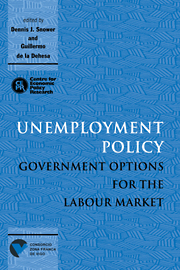Book contents
- Frontmatter
- Contents
- List of figures
- List of tables
- Preface
- Acknowledgements
- List of conference participants
- 1 Introduction
- PART ONE GENERAL POLICY ISSUES
- PART TWO DEMAND MANAGEMENT AND SUPPLY-SIDE POLICY
- PART THREE SUBSIDISING EMPLOYMENT AND TRAINING
- 6 The simple economics of benefit transfers
- Discussion
- Discussion
- 7 Wage subsidy programmes: alternative designs
- Discussion
- Discussion
- 8 Technological development, competition from low-wage economies and low-skilled unemployment
- Discussion
- 9 Macroeconomic and policy implications of shifts in the relative demand for skills
- Discussion
- 10 Would cutting payroll taxes on the unskilled have a significant impact on unemployment?
- Discussion
- 11 Preventing long-term unemployment: an economic analysis
- Discussion
- Discussion
- PART FOUR LABOUR MARKET REGULATIONS
- PART FIVE POLICY, JOB REALLOCATION AND THE UNEMPLOYMENT–PRODUCTIVITY RELATION
- PART SIX COMPARING UNEMPLOYMENT POLICIES
- Index
Discussion
Published online by Cambridge University Press: 07 September 2010
- Frontmatter
- Contents
- List of figures
- List of tables
- Preface
- Acknowledgements
- List of conference participants
- 1 Introduction
- PART ONE GENERAL POLICY ISSUES
- PART TWO DEMAND MANAGEMENT AND SUPPLY-SIDE POLICY
- PART THREE SUBSIDISING EMPLOYMENT AND TRAINING
- 6 The simple economics of benefit transfers
- Discussion
- Discussion
- 7 Wage subsidy programmes: alternative designs
- Discussion
- Discussion
- 8 Technological development, competition from low-wage economies and low-skilled unemployment
- Discussion
- 9 Macroeconomic and policy implications of shifts in the relative demand for skills
- Discussion
- 10 Would cutting payroll taxes on the unskilled have a significant impact on unemployment?
- Discussion
- 11 Preventing long-term unemployment: an economic analysis
- Discussion
- Discussion
- PART FOUR LABOUR MARKET REGULATIONS
- PART FIVE POLICY, JOB REALLOCATION AND THE UNEMPLOYMENT–PRODUCTIVITY RELATION
- PART SIX COMPARING UNEMPLOYMENT POLICIES
- Index
Summary
Richard Layard's chapter 11 is very stimulating, and contains an interesting policy proposal to prevent long-term unemployment. His ‘compulsory job scheme’ seems to have more advantages than similar previous schemes. It is neither a pure benefit transfer system (BTP), since work is compulsory, nor a workfare scheme, since the work is not for a benefit but for a regular wage (see also chapter 6 and 7 in this volume). It has also the advantage of avoiding cheating by the would-be long-term unemployed, given that they have to choose between taking a temporary job for six months or losing the unemployment benefit and keeping only their non-market activity income. Therefore, only in the case that the non-market income is much larger than the after-tax compulsory job wage they will choose the first option, but in both cases the free-riding of unemployment benefits will be excluded. Finally, it encourages the potential long-term unemployed to try to find a job before ending up at the compulsory temporary job offered by the proposed scheme.
Nevertheless, I see a series of practical shortcomings in the scheme that could easily be avoided. The first one is that the scheme supposes that it is possible to get a job precisely on day 360 of the unemployment benefit period. Even if the job is compulsory it takes some weeks to find a simple job that does not entail functional or geographical mobility, and even longer if it implies mobility.
- Type
- Chapter
- Information
- Unemployment PolicyGovernment Options for the Labour Market, pp. 349 - 351Publisher: Cambridge University PressPrint publication year: 1997



